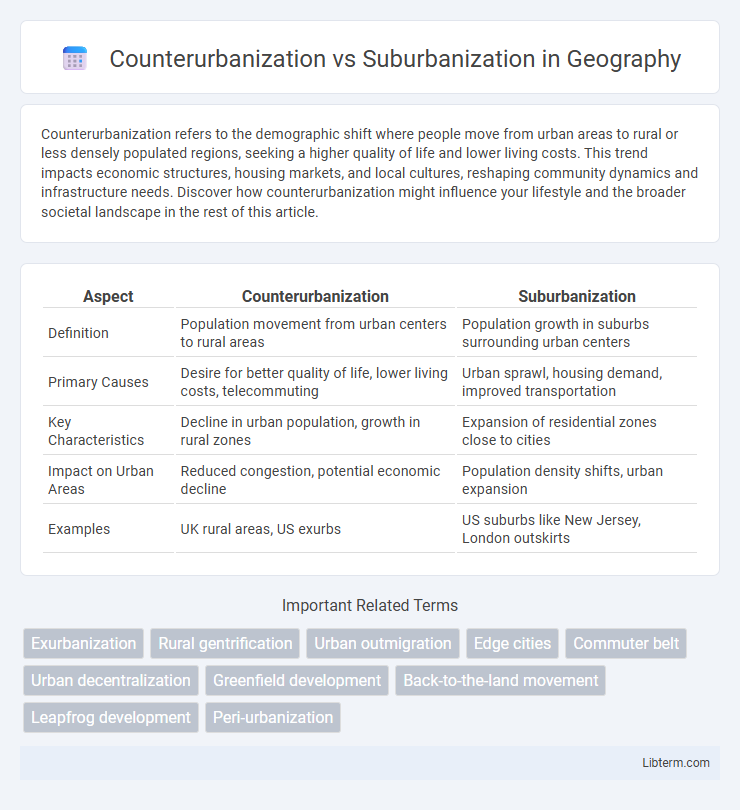Counterurbanization refers to the demographic shift where people move from urban areas to rural or less densely populated regions, seeking a higher quality of life and lower living costs. This trend impacts economic structures, housing markets, and local cultures, reshaping community dynamics and infrastructure needs. Discover how counterurbanization might influence your lifestyle and the broader societal landscape in the rest of this article.
Table of Comparison
| Aspect | Counterurbanization | Suburbanization |
|---|---|---|
| Definition | Population movement from urban centers to rural areas | Population growth in suburbs surrounding urban centers |
| Primary Causes | Desire for better quality of life, lower living costs, telecommuting | Urban sprawl, housing demand, improved transportation |
| Key Characteristics | Decline in urban population, growth in rural zones | Expansion of residential zones close to cities |
| Impact on Urban Areas | Reduced congestion, potential economic decline | Population density shifts, urban expansion |
| Examples | UK rural areas, US exurbs | US suburbs like New Jersey, London outskirts |
Understanding Counterurbanization: Definition and Trends
Counterurbanization refers to the demographic and social process where people move from urban areas to smaller towns, rural areas, or the countryside, driven by desires for improved quality of life, lower living costs, and less congestion. This trend contrasts with suburbanization, which involves the expansion of residential areas on the outskirts of cities, maintaining close ties to urban economic centers. Recent studies highlight that counterurbanization is influenced by advancements in remote work, improved transportation, and lifestyle preferences shifting towards sustainability and community-oriented living.
Suburbanization Explained: Key Characteristics
Suburbanization is characterized by the outward expansion of urban populations into surrounding rural areas, resulting in the development of residential neighborhoods, shopping centers, and infrastructure beyond the city core. Key features include lower population density compared to urban centers, increased reliance on automobiles for commuting, and a preference for single-family homes with larger yards. This process often leads to economic growth in peripheral zones, changes in land use patterns, and challenges such as urban sprawl and increased environmental impact.
Historical Context: Roots of Counterurbanization and Suburbanization
Suburbanization emerged in the late 19th and early 20th centuries as industrialization and improved transportation, such as streetcars and automobiles, enabled middle-class families to move from crowded urban centers to newly developed residential outskirts. Counterurbanization gained momentum in the late 20th century as advancements in remote work, rising urban property costs, and a desire for better quality of life prompted migration from metropolitan areas back to rural or smaller towns. Both movements reflect socio-economic responses to urban growth, technological progress, and changing lifestyle preferences across different historical periods.
Motivations Driving Counterurban Migration
Counterurbanization is driven primarily by the desire for a higher quality of life, including reduced pollution, less congestion, and more affordable housing, prompting individuals to move from urban centers to rural or semi-rural areas. Motivations also include the pursuit of natural amenities, increased privacy, and the opportunity for remote work enabled by digital technologies. In contrast, suburbanization is often motivated by factors such as access to urban employment, better schools, and family-friendly communities located close to city boundaries.
Factors Fueling Suburban Expansion
Suburban expansion is primarily driven by factors such as affordable housing, improved transportation infrastructure, and the desire for larger living spaces outside crowded urban centers. Economic opportunities in suburban areas, coupled with enhanced accessibility through highways and public transit, attract families seeking better quality of life. Additionally, zoning policies and low land costs encourage residential and commercial development in suburban regions.
Comparative Demographics: Who Moves Where?
Counterurbanization primarily attracts middle-aged and retired individuals seeking rural or small-town living, while suburbanization tends to draw younger families and professionals pursuing proximity to urban job centers. Migrants in counterurbanization often prioritize lifestyle changes, favoring lower population density and natural amenities, whereas suburbanization involves movements toward expanding metropolitan outskirts with access to schools and infrastructure. Demographic shifts reveal counterurban areas experiencing slower population growth and aging residents, contrasting with the more dynamic, diverse, and growing populations in suburban regions.
Economic Impacts: Counterurbanization vs Suburbanization
Counterurbanization often leads to economic decentralization, reducing congestion and lowering living costs in megacities while promoting growth in rural or smaller urban areas. Suburbanization drives economic expansion in metropolitan outskirts by increasing demand for housing, retail, and infrastructure, often boosting local job markets but potentially straining public services. Both trends impact regional labor markets, real estate values, and tax bases differently, influencing urban planning and economic policy decisions.
Environmental Consequences of Urban Population Shifts
Counterurbanization involves population movement from urban centers to rural areas, leading to increased land fragmentation, loss of agricultural land, and higher carbon footprints due to longer commute distances. Suburbanization expands urban peripheries, causing habitat destruction, increased air pollution, and greater reliance on automobiles. Both processes intensify environmental pressures by altering land use patterns and increasing resource consumption outside core urban areas.
Social and Cultural Implications
Counterurbanization results in the decentralization of communities, fostering tighter social bonds in rural or small-town settings, while suburbanization often sustains or amplifies social segregation based on socioeconomic status. The cultural implications of counterurbanization include the revival of local traditions and increased environmental awareness, contrasting with suburbanization's tendency to promote homogenized cultural patterns and consumer-driven lifestyles. Both phenomena reshape identity and social networks, yet counterurbanization typically encourages localized community engagement, whereas suburbanization may lead to more fragmented and car-dependent social structures.
Future Outlook: Urbanization Trends and Urban Planning
Counterurbanization involves the movement of populations from urban centers to rural areas, driven by desires for lower living costs and improved quality of life, while suburbanization expands urban footprints through residential developments on city outskirts. Future urbanization trends indicate a potential balance between these movements, influenced by advancements in remote work, transportation infrastructure, and sustainability-focused urban planning. Strategic urban planning will prioritize mixed-use developments, green spaces, and smart city technologies to manage growth effectively and mitigate sprawl, shaping resilient, adaptive metropolitan regions.
Counterurbanization Infographic

 libterm.com
libterm.com